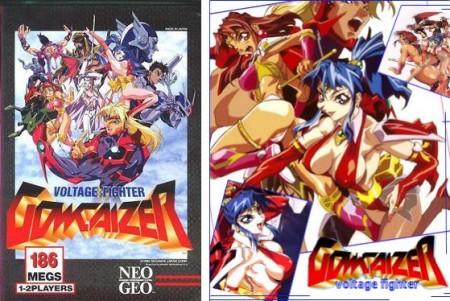Ask John: Does Gowcaizer Ever Make Sense?
Question:
A little web reseach reveals that 1997’s “travesty,” known to most English-speaking anime viewers as the VOLTAGE FIGHTER GOWCAISER movie was a compilation of three original separate episodes. By any remote chance, have you ever seen the separate episodes, and, if so, do they restore any sense to the otherwise incomplete and convoluted storyline, as depicted in the movie version?
Answer:
I’m not sure that a lot of anime fans know that director Masami Obari’s 1996 Choujin Gakuen Gowkaizer OVA series was actually an adaption of an earlier 1995 2D arcade fighting game created for SNK’s Neo-Geo system. The game was also ported to the Japanese Playstation. Masami Obari drew the original character designs for the game and even provided the voice for one of the game’s characters. The anime series originally consisted of a 45 minute long first episode and two 30 minute second and third episodes. Central Park Media originally released the three episodes on two domestic VHS tapes beginning in August 1998. The three episodes were released on a single domestic DVD in May 1999. CPM later released a new Voltage Fighter Gowcaizer DVD in January 25 that contained a slightly abbreviated “movie” edit of the series. I watched the first OVA episode when it premiered in the summer of 1996, and that may be all of the series I’ve ever watched. (I have CPM’s second edition DVD release on my shelf, but I’ve never unwrapped it.) My understanding, partially because my first-hand recollection is very vague, is that most of the footage missing from the “movie” version is flashback and recap footage and credits. The movie cut does lose the first action scene from the first OVA and reportedly some brief scenes that help flesh out characters and the plot. However, despite the original, uncut three episodes running roughly 13 minutes longer than the movie edit, viewers shouldn’t expect the three separate episodes to offer a drastically more comprehensible viewing experience.
Masami Obari’s sci-fi anime work from the mid and late 1990s, particularly Gowkaizer, Virus Buster Serge, Dangaizer 3, and Platinumhugen Ordian, are all typified by a number of consistent characteristics: thin but muscular men and disproportionately endowed women, an excessive use of fictional technobabble, and a heavy emphasis on kinetic, cyberpunk atmosphere with little concern for comprehensible narrative. Especially Obari’s late 90’s work epitomizes the aesthetic of style over substance. As a result, it’s widely dismissed by anime fans, although there are a few devotees who appreciate the pure exuberant, stylish design and energy of these productions. Masami Obari’s work before and after the late 1990s, characterized by early work on Bubblegum Crisis, Iczer-One, Hagane no Oni, and Detonator Orgun and later work on Dancougar Nova, Angel Blade, Viper GTS, Prism Ark, and Gravion anime has been more conventional and, one could say, more focused on creating anime for viewers instead of anime that fulfilled the director’s own aesthetics. Depending upon your personal perspective, creator/director Masami Obari’s signature work from the late 1990s – Gowkaizer, Virus Buster Serge, Dangaizer 3, Platinumhugen Ordian, and arguably Toshinden, excluding the Fatal Fury and Voogie’s Angels anime – is either the height or the depth of his output. These works seem to be the most relevatory of Obari’s personal interests and perspective. They’re his most stylized and distinctively recognizable anime productions. They’re also particularly distinctive in part because they really don’t make a lot of sense regardless of how you watch them. The separate three episode version of Voltage Fighter Gowcaizer, available on the first American DVD release and the Japanese DVD release, is the ideal way to watch the show, but even the original, longer three episode cut of the series isn’t especially comprehensive or comprehensible.
Add a Comment
You must be logged in to post a comment.



I dug Fatal Fury, and I’ve heard good things about Serge, but haven’t kept up with the rest. http://zanyvgquotes.com/gowcaizer/index.html